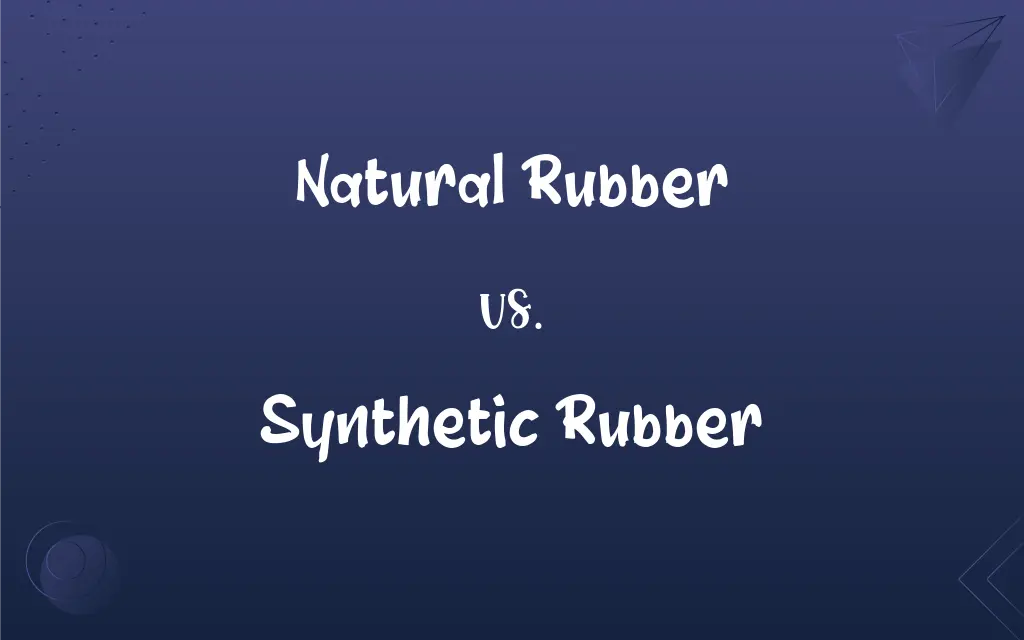Natural Rubber vs. Synthetic Rubber: What's the Difference?
Edited by Janet White || By Harlon Moss || Updated on October 21, 2023
Natural rubber is derived from the latex of rubber trees, while synthetic rubber is artificially produced from petrochemicals.

Key Differences
Natural rubber originates from the latex sap of rubber trees, primarily found in tropical regions. It's an organic substance that has been utilized for thousands of years for various applications. The elasticity, flexibility, and water resistance of natural rubber make it an invaluable resource for many industries.
Synthetic rubber, in contrast, is man-made and derived from petrochemicals. Its invention during the early 20th century came as a response to the demand for rubber surpassing the supply. Due to its artificial origin, synthetic rubber can be formulated to possess specific characteristics, making it adaptable to a range of applications.
Both natural rubber and synthetic rubber play crucial roles in the modern world. While natural rubber boasts qualities like superior resilience and tensile strength, synthetic rubber offers the advantage of being tailored to meet specific requirements, like resistance to oils or particular chemicals.
The production processes for natural rubber and synthetic rubber differ significantly. Natural rubber requires tapping rubber trees to collect latex, which is then coagulated and processed. Synthetic rubber involves chemical processes, combining various petrochemicals under specific conditions to produce different types of rubber.
In terms of environmental impact, natural rubber is biodegradable, but its cultivation can lead to deforestation. Synthetic rubber, being petroleum-based, can have a significant carbon footprint and is less environmentally friendly when it comes to degradation.
ADVERTISEMENT
Comparison Chart
Origin
Derived from the latex of rubber trees
Produced from petrochemicals
Historical Use
Used for thousands of years
Developed in the early 20th century
Characteristics
Superior resilience and tensile strength
Tailored properties like oil resistance
Production Process
Tapping rubber trees and processing latex
Chemical synthesis from petrochemicals
Environmental Impact
Biodegradable but can cause deforestation
Petroleum-based, significant carbon footprint
ADVERTISEMENT
Natural Rubber and Synthetic Rubber Definitions
Natural Rubber
Natural rubber originates from the sap of rubber plants native to tropical regions.
Sri Lanka is known for its production of high-quality natural rubber.
Synthetic Rubber
Synthetic rubber is a result of chemical synthesis, offering diverse applications.
Synthetic rubber's adaptability makes it prevalent in aerospace and automotive industries.
Natural Rubber
Natural rubber is known for its superior resilience and ability to stretch.
Bands made from natural rubber can stretch without easily breaking.
Synthetic Rubber
Synthetic rubber offers a consistent quality, making it preferable for some industrial applications.
Due to its consistency, synthetic rubber is often used in precision components.
Natural Rubber
Natural rubber is a biodegradable material used in various industries.
Eco-friendly brands often prefer natural rubber for its environmental benefits.
Synthetic Rubber
Synthetic rubber is a man-made alternative to natural rubber, tailored for specific properties.
Synthetic rubber seals resist oil better than their natural counterparts.
Natural Rubber
Natural rubber is a versatile organic substance with water-resistant properties.
Rain boots made from natural rubber keep feet dry during heavy downpours.
Synthetic Rubber
Synthetic rubber is an artificially produced elastic material derived from petrochemicals.
The tires on many cars are made from synthetic rubber for durability.
Natural Rubber
Natural rubber is an elastic material obtained from the latex of rubber trees.
The elasticity of natural rubber makes it perfect for making bouncy balls.
Synthetic Rubber
Synthetic rubber can be formulated to possess resistance to specific chemicals or conditions.
Chemical gloves made from synthetic rubber protect hands from harsh solvents.
FAQs
Which has been in use longer, natural rubber or synthetic rubber?
Natural rubber has been used for thousands of years, much longer than synthetic rubber.
How is synthetic rubber produced?
Synthetic rubber is produced from petrochemicals through chemical synthesis.
Where does natural rubber come from?
Natural rubber is derived from the latex sap of rubber trees.
Can synthetic rubber mimic the properties of natural rubber?
Yes, synthetic rubber can be formulated to replicate many properties of natural rubber and even improve upon some.
Is natural rubber biodegradable?
Yes, natural rubber is biodegradable.
Which rubber type is more resistant to chemicals?
Specific synthetic rubbers can be formulated to be highly resistant to certain chemicals.
Can synthetic rubber be tailored for specific uses?
Yes, synthetic rubber can be formulated for specific characteristics, such as oil or chemical resistance.
Are there different types of synthetic rubber?
Yes, there are multiple types of synthetic rubber, each with its unique properties and uses.
How is natural rubber processed?
Natural rubber is processed by tapping rubber trees to collect latex, which is then coagulated and further refined.
What products commonly use synthetic rubber?
Products like tires, seals, hoses, and footwear often utilize synthetic rubber.
Why was synthetic rubber developed?
Synthetic rubber was developed in response to a shortage of natural rubber and to meet specific industrial needs.
What are the environmental impacts of synthetic rubber?
Synthetic rubber, being petroleum-based, has a significant carbon footprint and is less biodegradable than natural rubber.
Which type of rubber is more resilient?
Natural rubber typically boasts superior resilience compared to most synthetic rubbers.
Are there shortages of natural rubber?
Occasionally, factors like diseases, climate changes, or economic conditions can lead to shortages of natural rubber.
Is synthetic rubber more consistent in quality than natural rubber?
Generally, synthetic rubber offers more consistent quality due to its controlled production process.
Which rubber is more eco-friendly?
Natural rubber is biodegradable, making it more eco-friendly, but its cultivation can lead to deforestation.
Can allergies be linked to natural rubber?
Yes, some individuals have latex allergies linked to natural rubber.
Are the costs of natural rubber and synthetic rubber comparable?
Costs can vary based on market conditions, but often synthetic rubber can be more cost-effective due to scalable production.
Can synthetic rubber replace natural rubber in all applications?
While synthetic rubber can replace natural rubber in many applications, certain uses might still favor the unique properties of natural rubber.
How has the invention of synthetic rubber impacted industries?
The invention of synthetic rubber has allowed industries to have a consistent supply and meet specific needs that natural rubber couldn't address.
About Author
Written by
Harlon MossHarlon is a seasoned quality moderator and accomplished content writer for Difference Wiki. An alumnus of the prestigious University of California, he earned his degree in Computer Science. Leveraging his academic background, Harlon brings a meticulous and informed perspective to his work, ensuring content accuracy and excellence.
Edited by
Janet WhiteJanet White has been an esteemed writer and blogger for Difference Wiki. Holding a Master's degree in Science and Medical Journalism from the prestigious Boston University, she has consistently demonstrated her expertise and passion for her field. When she's not immersed in her work, Janet relishes her time exercising, delving into a good book, and cherishing moments with friends and family.































































